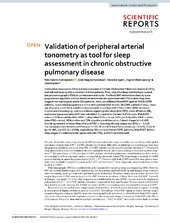| dc.contributor.author | Holmedahl, Nils Henrik | |
| dc.contributor.author | Fjeldstad, Odd-Magne | |
| dc.contributor.author | Engan, Harald | |
| dc.contributor.author | Saxvig, Ingvild W. | |
| dc.contributor.author | Grønli, Janne | |
| dc.date.accessioned | 2020-05-13T11:50:39Z | |
| dc.date.available | 2020-05-13T11:50:39Z | |
| dc.date.issued | 2019-12-18 | |
| dc.Published | Holmedahl NH, Fjeldstad O, Engan HK, Saxvig IW, Grønli J. Validation of peripheral arterial tonometry as tool for sleep assessment in chronic obstructive pulmonary disease. Scientific Reports. 2019;9:19392 | eng |
| dc.identifier.issn | 2045-2322 | |
| dc.identifier.uri | https://hdl.handle.net/1956/22231 | |
| dc.description.abstract | Obstructive sleep apnea (OSA) worsens outcomes in Chronic Obstructive Pulmonary Disease (COPD), and reduced sleep quality is common in these patients. Thus, objective sleep monitoring is needed, but polysomnography (PSG) is cumbersome and costly. The WatchPAT determines sleep by a pre-programmed algorithm and has demonstrated moderate agreement with PSG in detecting sleep stages in normal subjects and in OSA patients. Here, we validated WatchPAT against PSG in COPD patients, hypothesizing agreement in line with previous OSA studies. 16 COPD patients (7 men, mean age 61 years), underwent simultaneous overnight recordings with PSG and WatchPAT. Accuracy in wake and sleep staging, and concordance regarding total sleep time (TST), sleep efficiency (SE), and apnea hypopnea index (AHI) was calculated. Compared to the best fit PSG score, WatchPAT obtained 93% sensitivity (WatchPAT = sleep when PSG = sleep), 52% specificity (WatchPAT = wake when PSG = wake), 86% positive and 71% negative predictive value, Cohen’s Kappa (κ) = 0.496. Overall agreement between WatchPat and PSG in detecting all sleep stages was 63%, κ = 0.418. The mean(standard deviation) differences in TST, SE and AHI was 25(61) minutes (p = 0.119), 5(15) % (p = 0.166), and 1(5) (p = 0.536), respectively. We conclude that in COPD-patients, WatchPAT detects sleep stages in moderate to fair agreement with PSG, and AHI correlates well. | en_US |
| dc.description.abstract | Obstructive sleep apnea (OSA) worsens outcomes in Chronic Obstructive Pulmonary Disease (COPD), and reduced sleep quality is common in these patients. Thus, objective sleep monitoring is needed, but polysomnography (PSG) is cumbersome and costly. The WatchPAT determines sleep by a pre-programmed algorithm and has demonstrated moderate agreement with PSG in detecting sleep stages in normal subjects and in OSA patients. Here, we validated WatchPAT against PSG in COPD patients, hypothesizing agreement in line with previous OSA studies. 16 COPD patients (7 men, mean age 61 years), underwent simultaneous overnight recordings with PSG and WatchPAT. Accuracy in wake and sleep staging, and concordance regarding total sleep time (TST), sleep efficiency (SE), and apnea hypopnea index (AHI) was calculated. Compared to the best fit PSG score, WatchPAT obtained 93% sensitivity (WatchPAT = sleep when PSG = sleep), 52% specificity (WatchPAT = wake when PSG = wake), 86% positive and 71% negative predictive value, Cohen’s Kappa (κ) = 0.496. Overall agreement between WatchPat and PSG in detecting all sleep stages was 63%, κ = 0.418. The mean(standard deviation) differences in TST, SE and AHI was 25(61) minutes (p = 0.119), 5(15) % (p = 0.166), and 1(5) (p = 0.536), respectively. We conclude that in COPD-patients, WatchPAT detects sleep stages in moderate to fair agreement with PSG, and AHI correlates well. | en_US |
| dc.language.iso | eng | eng |
| dc.publisher | Springer | eng |
| dc.rights | Attribution CC BY | eng |
| dc.rights.uri | http://creativecommons.org/licenses/by/4.0/ | eng |
| dc.title | Validation of peripheral arterial tonometry as tool for sleep assessment in chronic obstructive pulmonary disease | eng |
| dc.type | Peer reviewed | |
| dc.type | Journal article | |
| dc.date.updated | 2020-02-07T09:06:50Z | |
| dc.description.version | publishedVersion | |
| dc.rights.holder | Copyright 2020 Springer Nature Limited | eng |
| dc.identifier.doi | https://doi.org/10.1038/s41598-019-55958-2 | |
| dc.identifier.cristin | 1785710 | |
| dc.source.journal | Scientific Reports | |

